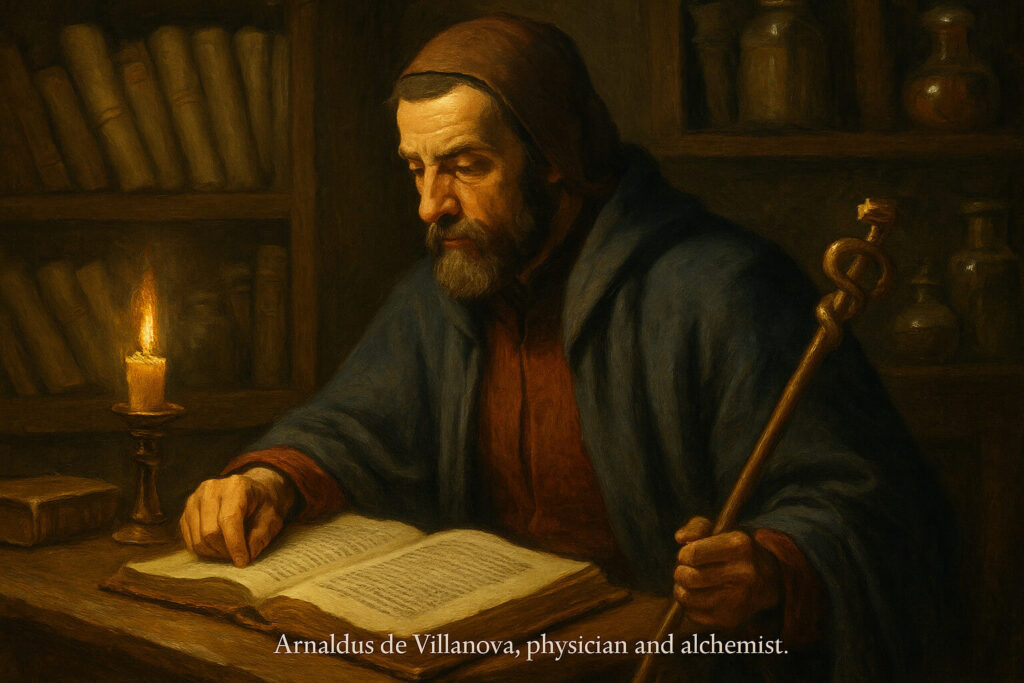Philosopher's Stone Part Five: Epistle of Arnaldus de Villanova to the King of Naples — The One Mercurial Nature

Philosopher’s Stone Part Five:
Epistle of Arnaldus de Villanova to the King of Naples — The One Mercurial Nature
Bibliographic Introduction
Arnaldus de Villanova (c. 1240–1311) was a physician, theologian, and alchemist of great renown in medieval Europe. His works on medicine, such as translations of Galen and treatises on regimen, gained him high status in royal courts and universities. Yet he also produced writings on the philosophers’ stone, blending scholastic rigor with mystical fervor. Among these is the Epistle to the King of Naples, a short tract addressed to Robert of Anjou.
In this letter, Arnaldus sets out the doctrine of the Stone with remarkable brevity. He insists on unity: one stone, one subject, one operation. He also stresses the error of taking common quicksilver for the philosophers’ mercury. The Epistle thus becomes a touchstone for understanding how late thirteenth-century scholastic alchemy sought to correct vulgar misunderstandings while defending the possibility of transmutation.
The text survives in multiple manuscript copies and was printed in collections of alchemical epistles. The version examined here is from the PDF you provided (Epistola ad Regem Neapolitanum, English translation).
Philosophical Mercury in Arnaldus
Arnaldus opens with an axiom:
“The philosophers’ stone is but one, composed of four elementary principles, and one mercurial nature, in which all philosophers agree.”
This “one mercurial nature” is not common quicksilver:
“Beware of taking vulgar quicksilver, for this is not the argent vive of the sages, but only a shadow of it.”
Here Arnaldus makes a decisive move. Philosophical mercury is described as a special humidity, hidden within metallic bodies, possessing both fixed and volatile qualities. It is not the crude mercury of apothecaries but a purified, essential form embedded in the substance of metals themselves.
He further notes that the Stone is a metallic substance, not vegetable or animal, and that its perfection comes through a balance of sulfur and mercury properly united. This “argent vive of the sages” is, in effect, a middle principle: neither entirely volatile like quicksilver, nor fixed like gold, but capable of both states.
Extracting the Method
Arnaldus provides no step-by-step recipe, but he outlines the logic of the work:
-
One Matter: The Stone is composed of one thing, drawn from metallic substance, embodying the four elements.
-
Not Common Mercury: The starting point is not apothecaries’ mercury, but a concealed mercurial nature found within metals.
-
Dissolution: Bodies must be reduced to their first matter by dissolution.
-
Putrefaction: Corruption and blackness signify the beginning of transformation.
-
Color Sequence: Whiteness follows, then redness.
-
Fixation: The volatile is rendered stable; the Stone becomes incombustible.
Arnaldus frames this as the universal consensus of the philosophers: one subject, one vessel, one fire. His innovation is not in the operations—these echo the Turba and Artephius—but in clarifying what mercury is not. By excluding common quicksilver, he narrows the field of candidates for the true matter.
Evidence of Practice
The Epistle is short and schematic. It lacks the vivid details of sublimation or distillation that betray laboratory experience. Arnaldus was primarily a physician and theologian; his alchemical writings are more scholastic arguments than workshop manuals. Still, his insistence on excluding common quicksilver suggests familiarity with failed experiments: perhaps he saw students wasting time with metallic mercury and sought to correct them.
Thus, Arnaldus appears as a systematizer, not a bench operator. His authority derives from his reputation and his synthesis of older sources, not from laboratory innovation.
Contribution to the Stone Tradition
The Epistle contributes three important clarifications:
-
Unity: The Stone is one, with one mercurial nature and one process.
-
Exclusion: Common quicksilver is not the argent vive of the sages. This demarcates philosophical mercury from vulgar materials.
-
Method Reminder: Dissolution, putrefaction, whitening, reddening remain the order of work.
Placed after Artephius and Pseudo-Geber, Arnaldus serves as a corrector. Where Artephius promoted antimony, and Pseudo-Geber focused on purified mercury, Arnaldus warns: do not confuse the philosophers’ mercury with the quicksilver of commerce. His emphasis is on guarding the definition, not expanding the recipe.
Deciphered Method
Arnaldus’ method, in distilled form:
-
Identify the true mercurial nature within metals, not vulgar mercury.
-
Dissolve the body to first matter.
-
Allow putrefaction to blacken the matter.
-
Continue until it whitens, then reddens.
-
Fix the volatile, creating an incombustible Stone.
Though schematic, this framework reinforces the canon: dissolution, putrefaction, whitening, reddening, fixation—always with the true, hidden mercury, never the vulgar.
Conclusion
The Epistle to the King of Naples is brief but decisive. Arnaldus de Villanova does not expand the laboratory repertoire but clarifies a central definition: the philosophers’ mercury is not common quicksilver, but a hidden mercurial principle within metals. His voice exemplifies the scholastic alchemist, defending unity and warning against vulgar misreadings.
For our project, Arnaldus marks a turning point: the doctrine of exclusion. The sages’ mercury is defined by what it is not. This move forces us, even now, to ask: what is this hidden mercurial nature, if not chemical mercury, antimony, or vinegar? Arnaldus does not answer, but he preserves the question with scholastic precision.
Available in his collected works. You can hold it in your hands here.
| Author / Text | Philosophical Mercury | Preparation Steps | Union Method | Fire / Heat | Color Signs | Product Claims |
|---|---|---|---|---|---|---|
| Zosimos of Panopolis (c. 300 CE) | “Divine water” in the kerotakis; volatile spirit ascending and descending | Calcination, sublimation, distillation, washing | Circulation in sealed vessel; dissolution and recombination | Gentle, regulated heating; moist fire | Blackening, whitening, reddening | Tincture, purification of metals; spiritual rebirth |
| Emerald Tablet (Arabic/Latin, 9th–12th c.) | “One Thing” mediating heaven and earth; volatile principle implied | None explicit; “separate the subtle from the gross” | Circulation: ascent and descent of the subtle | Not named; implied gentle force | None specified; allegorical “glory of the whole” | Perfection of all things; universal power |
| Turba Philosophorum (12th c., Arabic → Latin) | Permanent water: vinegar/gum/spume of Luna; volatile-fixative solvent | Putrefaction 40 days; washing; imbibition; coagulation | Copper (sometimes with lead/tin) dissolved in permanent water | Gentle fire; sealed vessel; staged regimen | Blackening → Whitening → Reddening → Tyrian purple | Tincture of metals; Stone “not a stone”; invariable color |
| Artephius, Secret Book (12th c.) | Hidden mercury within antimony; combined with gold | Dissolution of Sol/Luna in “living water” (moist fire); putrefaction | Antimony + mercury + gold in one vessel | Gentle, continuous heat (“hen brooding eggs”) | Black → White → Red | Incombustible oil; multiplicative tincture; longevity |
| Pseudo-Geber, Summa Perfectionis (13th c.) | Purified, sublimed, partly fixed quicksilver | Repeated sublimation with salts/vitriols; fixation of volatile | Mercury + purified sulfur joined in vessel | “Convenient fire”: moderate, continuous decoction | Black → White → Red | Philosophers’ Stone (Elixir); projection of metals; medicinal virtues |
| Arnaldus de Villanova, Epistle (late 13th–early 14th c.) | Hidden mercurial humidity within metallic bodies; not common quicksilver | Dissolution, putrefaction | Unite body and hidden mercury in vessel | Gentle, continuous fire | Black → White → Red | Incombustible Stone; tincture of metals |
